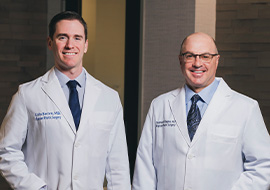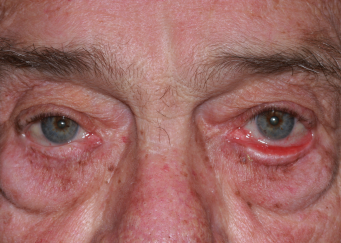Common Questions
How long does it take to heal after surgery?
Following surgery, cold compresses (ice packs) and a topical antibiotic ointment are applied for 3 to 4 days followed by warm compresses. Eye patches are not required. Discomfort is usually minimal and is typically handled by acetaminophen (Tylenol®). Aspirin containing compounds and non-steroidal anti-inflammatory products (Advil, Ibuprofen, etc.) should be avoided 1 weeks prior to surgery and a few days following surgery. Most individuals will have swelling and some degree of bruising that will gradually improve over the first 1 to 3 weeks. Swelling make take weeks or months to completely resolve. Patient healing is variable with some individuals healing much quicker than others. Makeup can be applied to help hide residual bruising, usually starting two weeks after surgery.
For upper eyelid blepharoplasty, 3-4 days off work is average while up to 8 to 10 days may be best for those patients having both an upper and lower eyelid blepharoplasty. Patient's with occupations requiring minimal physical activity may return to work sooner. Patients may have diminished blinking and incomplete eyelid closure following eyelid surgery, particularly ptosis repair. Frequent ocular lubrication may be required for several weeks or months after eyelid surgery. Contact lens wear is typically avoided during the first 3 weeks after surgery or until adequate blinking and eyelid closure returns. After Surgery Instructions
How long will I be bruised and swollen following my surgery?
The amount of swelling and bruising varies from patient to patient and even from the left and right sides in the same patient. Mild bruising may resolve in 2-4 days, whereas more significant bruising may last 10-14 days. Patients may wish to hold blood thinner medications (such as aspirin, ibuprofen, some arthritis medications, Plavix, Coumadin, etc.) prior to surgery in order to minimize the risk of severe bleeding and bruising. Patients should only modify their medication regimen with the advice of their primary care physician, cardiologist, or other prescribing physician.
Eyelid and facial swelling tends to worsen the first few days following surgery. Ice packs, head elevation, and rest may help minimize swelling. Swelling (edema) will often improve considerably over the first 2-3 weeks after surgery but may take several weeks and even months to completely resolve. Go to Postoperative Care to learn more.
What type of anesthesia is used during surgery?
Office procedures are performed with local anesthesia which may include eye drops and small injections under the skin in the area requiring surgery.
Surgeries performed in an ambulatory care center or hospital are usually performed with intravenous sedation administered by an anesthesiologist. Some surgeries, such as orbital procedures, are performed under general anesthesia.
Dr. Klapper will be able to discuss anesthesia options once a surgical plan has been developed.

More information on Ectropion
Ectropion
Ectropion is an outward turning of the eyelid margin. Ectropion can cause dryness of the eyes, excessive tearing, red eyes, and increased sensitivity to light and wind. It may occur unilaterally or bilaterally and is almost always in the lower eyelid. Acquired causes of ectropion include: involutional (due to aging changes), paralytic (due to seventh cranial nerve palsy), cicatricial (due to scarring), inflammatory, or mechanical.
Acquired Ectropion
Involutional ectropion is the most common form of ectropion. The etiology of involutional ectropion is similar to that of involutional entropion. Progressive laxity of the supportive structures of the eyelid is present in both conditions. In ectropion, however, normal or decrease orbicularis muscle (eyelid muscle) tone results in the eyelid turning out. The ectropion may just involve the medial portion of the lid or it may involve the entire lid.
Paralytic Ectropion
Temporary or permanent seventh cranial nerve palsy (due to surgery or a Bell’s palsy) often results in paralytic ectropion of the lower eyelid. The orbicularis muscle loses its tone and the eyelid falls outward. Poor blinking and eyelid closure leads to chronic eye irritation.
Cicatricial Ectropion
Any type of scarring process of the eyelid or facial skin may result in eversion of the eyelid. It may occur following chemical or thermal burns to the face, trauma, or previous eyelid surgery. Dermatologic conditions such as rosacea, atopic dermatitis, eczema, and ichthyosis may also cause cicatricial ectropion.
Mechanical Ectropion
Bulky tumors of the eyelid may weigh down the lower eyelid resulting in eversion of the lid. Poorly fit or heavy spectacles may also pull a lax or loose eyelid outward.
The Treatment of Ectropion
 Watch to learn more about Ectropion Surgery
Watch to learn more about Ectropion Surgery
Ectropion treatment, for the most part, is surgical. The only form of ectropion that may be amenable to temporizing measures is the paralytic form secondary to seventh cranial nerve palsies. In these cases, the use of lubricating eye drops and ointment combined with taping the eyelids closed at night may be successful in keeping the eye comfortable for a brief time in anticipation of recovery of seventh nerve function (Bell’s palsy).
Surgery is generally performed with local anesthesia as an outpatient. The surgery involves tightening the lower eyelid and turning the eyelid margin back into its normal position. If a cicatricial process is present, the skin disease should be treated first. If the eyelid is still turned out once the skin is quiet and the dermatitis has resolved, a full-thickness skin graft or local skin-muscle (myocutaneous) flap may be required. Skin may be taken from the upper eyelid(s), in front of or behind the ear, or just above the clavicle if a skin graft is required.
Ectropion, Male, 82 years old
 BeforeBefore
BeforeBefore AfterAfter
AfterAfter
More information on Ectropion
